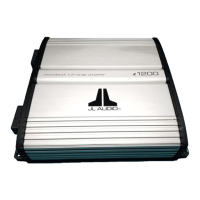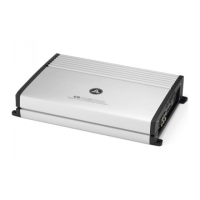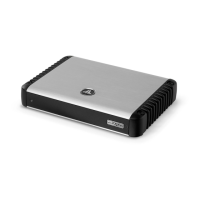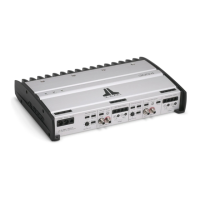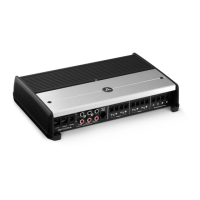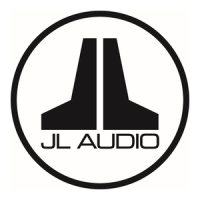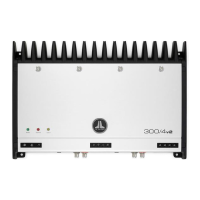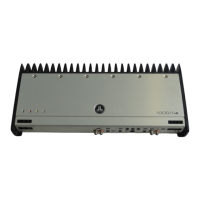12 | JL Audio - RD400/4 Owner’s Manual
B) Fade Subwoofer Level vs. HF Level
Req uired: a source unit or processor with two
pairs of stereo outputs.
Inp ut Connections: the first stereo pair of source
unit outputs is connected to the “CH 1 (Left)”
and “CH 2 (Right)” inputs of the RD400/4.
The second stereo pair of source unit outputs
is connected to the “CH 3 (Left)” and “CH 4
(Right)” inputs (select “4 Ch.” on the “Input
Mode” switch).
Res ult: in this mode, the user has the ability
to fade or control the level of the LF
channels relative to the HF channels via
the source unit’s fader control without
exceeding the maximum clean output
level set by each amplifier section’s
“Input Sensitivity” controls.
C) Subwoofer Level Control Only:
Req uired: a source unit or processor with
one pair of stereo outputs and dedicated
subwoofer outputs.
Inp ut Connections: the main stereo pair of
source unit outputs is connected to the
“CH 1 (Left)” and “CH 2 (Right)” inputs
of the RD400/4. The source unit’s dedicated
subwoofer output is connected to the “CH
3 (Left)” and “CH 4 (Right)” inputs (select
“4 Ch.” on the “Input Mode” switch).
Res ult: in this mode, the user has the ability to
control the absolute level of the LF channels
relative to the HF channels.
Set the “Input Sensitivity” in the “Channel 3 &
4 Controls” section with the source unit’s
subwoofer level control set at 3/4 of full output.
See Appendix A (page 14) for details.
Crossover Setup for Bi-Amplified System
with one RD400/4:
Once the input sections have been configured
appropriately, go to the “Channel 3 & 4
Controls”. Select “LP” (low-pass) on the “Filter
Mode” switch and an appropriate “Filter Freq.”
(80 Hz is a good starting point).
Next, turn your attention to the “Channel 1 &
2 Controls” and select “HP” (high-pass) on the
“Filter Mode” switch and an appropriate “Filter
Freq.” (again, 80 Hz is a good starting point).
After proper adjustment of the “Input
Sensitivity” controls for both channel pairs using
the method shown in Appendix A (page 14), you
can fine tune filter frequencies and attenuate
either pair of channels to achieve proper balance.
MULTIAMPLIFIER SYSTEMS
Using the “Preamp Outputs” of the
RD400/4, it is easy to configure many
different multi-amplifier systems.
The most common type involves the addition
of a subwoofer amplifier, such as the RD500/1.
Common configurations of such a system are
described as follows.
Bi-Amplified System with one RD400/4 in
four-channel mode and a separate
subwoofer amplifier
This configuration requires that the separate
subwoofer amplifier has a built-in low-pass filter.
(All JL Audio amplifiers have this feature.)
In this configuration, channels 1&2 of the
RD400/4 will drive front component speakers
in stereo with high-pass filtering. Channels 3&4
will drive rear component speakers in stereo, also
with high-pass filtering. The separate amplifier
will drive the subwoofer system with low-pass
filtering (80 Hz is a good starting point).
Here are three possible configuration options:
A) Fade Subwoofer Level vs. HF Level:
Req uired: a source unit or processor with front
and rear pairs of stereo outputs.
Inp ut Connections: one stereo pair of source unit
outputs is connected to the “CH 1 (Left)” and
“CH 2 (Right)” inputs of the RD400/4 (select
“2 Ch.” on the “Input Mode” switch). The
second stereo pair of source unit outputs is
connected to the subwoofer amplifier inputs.
Res ult: with this option, the user has the ability to
fade the level of the subwoofer amplifier’s input
relative to the HF channels, but cannot control
front-to-rear fading of the HF channels. The
relative level of the front and rear HF channels
will be fixed by the RD400/4’s
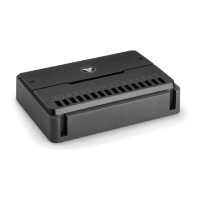
